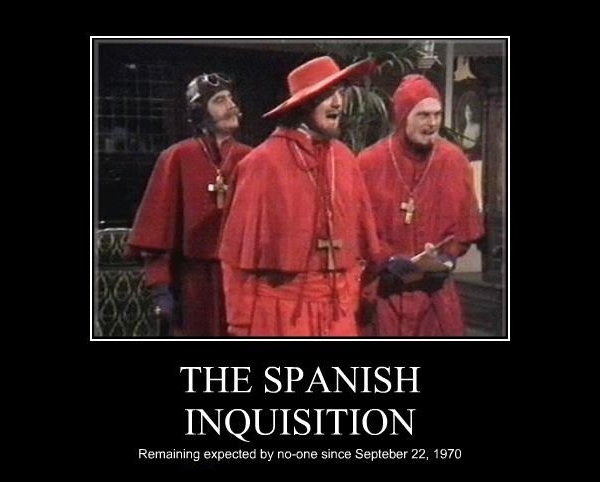The Spanish Inquisition: Debunking the Legends
by Douglas Beaumont
Filed under Inquisition
The Catholic Church is often the victim of the same kinds of urban legends that surround the Titanic or Aspartame. Whether it is the Crusades, the Spanish Inquisition, chained church Bibles, or Galileo, people are being led to believe falsehood and making bad decisions based on those falsehoods. Given the gravity of the decisions being made, any intelligent person deserves to have the facts.
If there is a hierarchy to urban legends that skeptics use to try to discredit the Catholic Church, the Spanish Inquisition is probably at the top. It’s an easy one, because most people think they know enough about it to not ask questions, and the knee-jerk reaction to the images brought to mind of thousands being tortured or killed for their beliefs are usually all one needs to make the point: the Church is untrustworthy at best, and genuinely evil at worst.
However, it turns out most of what people think they know about the inquisition is simply not true. The urban legends surrounding the Spanish Inquisition span from Reformation-era England to modern-day Fundamentalism, and are unfortunately so widespread that even many Christians believe them. To put it up front: yes, there were abuses done in the name of the Church—some committed by members of the Church. The urban legends concern the nature and extent of the abuses, as well as who was responsible for them. Although the evils present during various phases of the Inquisition were very real, should not be defended, and have been admitted by the Church, many historical misunderstandings and falsehoods based in anti-Spanish or anti-Catholic propaganda remain to this day.
Quick Summary
Modern historical research has uncovered facts that dismantle many of these centuries-old falsehoods. Here are some quick corrections concerning popular misunderstandings:
- The Inquisition was originally welcomed to bring order to Europe because states saw an attack on the state’s faith as an attack on the state as well.
- The Inquisition technically had jurisdiction only over those professing to be Christians.
- The courts of the Inquisition were extremely fair compared to their secular counterparts at the time.
- The Inquisition was responsible for less than 100 witch-hunt deaths, and was the first judicial body to denounce the trials in Europe.
- Though torture was commonly used in all the courts of Europe at the time, the Inquisition used torture very infrequently.
- During the 350 years of the Spanish Inquisition, between 3,000-5,000 people were sentenced to death (about 1 per month).
- The Church executed no one.
What was the Spanish Inquisition?
In order to understand the urban legend status of the Spanish Inquisition, one must first understand the Inquisition in general. Existing in various parts of Europe as early as the 12th Century, the inquisition was part of the judicial system of the Church which dealt with heresy. The Bible records instances where God commanded that formal inquiries were to be carried out to discover believers in false religions (e.g., Deuteronomy 17:2–5; 13:5, 17:7, 12; cf. 1 Corinthians 5:13), and this idea was put into practice in the time when the Church and state were much more closely associated than they are today. Although, as part of the Church, the Inquisition was concerned only with its own members, loyalty to the Church assumed loyalty to the State and vice versa. This may seem unfair or oppressive, but it is how things were back then.
The original Inquisition of the 12th Century concerned the Catharists who blended Gnosticism with Manichaeism and believed in two gods. Their beliefs led to potentially civilization-destroying social consequences. Catharists refused to take oaths, which back then meant opposing government authority. Marriage was considered sinful while secret fornication was permitted. Even suicide was encouraged. These were not faithful bands of “Bible Christians” or a hidden “remnant” of true believers trying to avoid the evil institutional Church. Eventually Europe was so endangered by this group heresy that the Inquisition seemed to be a political necessity.
By the late Middle Ages, the subjects of Portugal and Spain were often Muslim or Jewish, and the re-conquering of those lands created a clash between these subjects and the Crown as well as the Church. King Ferdinand II of Aragon and Queen Isabella I of Castile thus established the Spanish Inquisition in 1478 to weed out any remaining traitor-heretics (mostly focusing on converted Jews). Unlike the historical Inquisition of the Church, this Inquisition was essentially controlled by the secular government (even when staffed by clergy). It thus operated largely outside the control of the Church. In fact, when abuses were reported, Pope Innocent VIII complained to no avail.
Facts and Fictions
Two major factors make a fair evaluation of the Spanish Inquisition difficult today. The first is that most of what we think we know about it is simply not true. The second is that we judge the realities of the Spanish Inquisition according to modern Western sentiments. Most of European life in the period covered by the Inquisition would be judged barbaric by this standard, and, ironically, the Inquisition was actually rather progressive compared to the rest of the world at the time. Here are some specific examples:
Fairness in Trials
Although the days of having court-appointed lawyers and access to one’s accusers were a long way off, at one time the Spanish Inquisition was widely hailed as the best run, most humane court in Europe. There are records of people committing blasphemy in secular courts so they could have their case would fall under the Inquisition’s jurisdiction. Further, the Inquisition was the first to pronounce Europe’s witch hunt a delusion and prohibited anyone from being tried or burnt for witchcraft (the number of witches killed by the inquisition was less than 100 out of over 125,000 trials).
When the Inquisition found someone guilty of heresy, most of the sentences were not unfair—many simply required the performance of some penitential good works. Heretics were unrepentant threats to the state—not confused, simple folk (in fact, the Inquisition had little impact on the vast majority of people because it simply did not exist in many rural areas). Finally, while verdicts of guilty or not-guilty fell to the inquisitors, the use of violent punishments was up to the secular authorities.
Use of Torture
Most of the torture and executions attributed to the Church during the various inquisitions didn’t occur at all, and historians now concede that Inquisition torture chambers never existed. Torture was indeed used during some Inquisition trials (hardly uncommon for the court system of the time). The Inquisition, though, had strict rules regarding its use that put it far ahead of its time.
Torture was unauthorized until 20 years after the Inquisition began. It was first authorized by Pope Innocent IV in 1252—not as a mode of punishment, but as a means of discovering truth. It was not to be used to threaten life or cause loss of limb, was to applied only if the accused was uncertain and seemed already convicted by many weighty proofs, and after all other options had been used. When it was used it was not to be used more than once, and for no more than 15 minutes. Unfortunately these rules were sometimes circumvented by creative readings of the rule book. Torture was most cruelly used under the pressure of secular authority (Frederick II, for instance, abused the Inquisition to persecute his personal enemies). So, while torture was used in some cases, the idea of continent-spanning torture and death caused by the Church is simply not the case.
There were no rapes, feet burning, creative torture chambers, iron maidens, etc., and reports show that between 98%-99% of all Inquisition trials did not involve torture at all. Compared to secular courts that decreed the death penalty for damaging shrubs in England, or disembowelment for sheep-stealing in France, the Inquisition was actually far more conservative than the secular Europe of the day.
Death Toll
No one knows exactly how many people perished because of the Inquisition, but it is thought to be between 3,000 and 5,000 people during the 350 years of its existence. Some writers quote figures so wildly impossible it is amazing they have any purchase at all (I’ve seen numbers nearing 95 million—more than the entire population of the countries the Inquisition was held in!).
In 1998, Pope John Paul II stated that “The Inquisition belongs to a tormented phase in the history of the Church, which...Christians [should] examine in a spirit of sincerity and open-mindedness...[I]t is necessary to know the facts exactly and to recognize the deficiencies in regard to evangelical exigencies in the cases where it is so.”
Six years later, a symposium commissioned to study the Inquisition released its findings: the total number of accused heretics put to death during the Spanish Inquisition comprised 0.1 percent of the more than 40,000 who were tried. In some cases the Inquisition saved heretics from secular authorities.
Historical vs. Urban Legend Sources
If all this is true, then where did the misunderstandings come from? Political attacks on Spain (which was being equated with the Inquisition) and Protestant propagandists (identifying themselves with the heretical “martyrs” of ages past), resulted in the publication of falsehoods that were distributed via the new printing press throughout Europe. People like William of Orange and Montanus basically set the stage for historical thinking on the Inquisition for centuries to come—the so-called “Black Legend” of Inquisition terror. Further, activists, politicians, and even artists turned the Inquisition into a symbol of religious intolerance during the Enlightenment age which followed the Protestant revolution.
In recent years, however, the Vatican opened up its secret archives for historical investigation. Inquisition records that were made by and for the Inquisition were allowed to be researched for the first time in history. Since then, the above facts have been generally discoverable in modern history books (whether Catholic or not). Corrected Inquisition history can be found in sources such as Inquisition by Edward Peters and The Spanish Inquisition: An Historical Revision by Henry Kamen. Comparative secular documentaries include The Myth of the Spanish Inquisition (BBC) and the more sensationalistic The Spanish Inquisition (History Channel).
Conclusion: What Does this Say About the Church?
When looking at the facts of the Inquisition, and placing those facts in their proper historical context, the picture we discover is far less terrible than is been believed. Even so, there were certainly abuses committed in the name of Christianity during the Inquisition. The question is, did the Church encourage theses abuses? The Church is most aware of her own failings and that she contains all sorts of sinners. She even knows some of them manage to work their way into positions of authority (Acts 20:29; Matt. 7:15).
But what matters for the Church, and what it should be judged by, is what it actually teaches. It would be absurd to criticize the Church for something done against what it advocates. Just as we don't judge the efficacy of a medicine by those who refuse to take it, so we should judge the Church only by her actual teachings and official actions.
Related Posts
Note: Our goal is to cultivate serious and respectful dialogue. While it's OK to disagree—even encouraged!—any snarky, offensive, or off-topic comments will be deleted. Before commenting please read the Commenting Rules and Tips. If you're having trouble commenting, read the Commenting Instructions.













